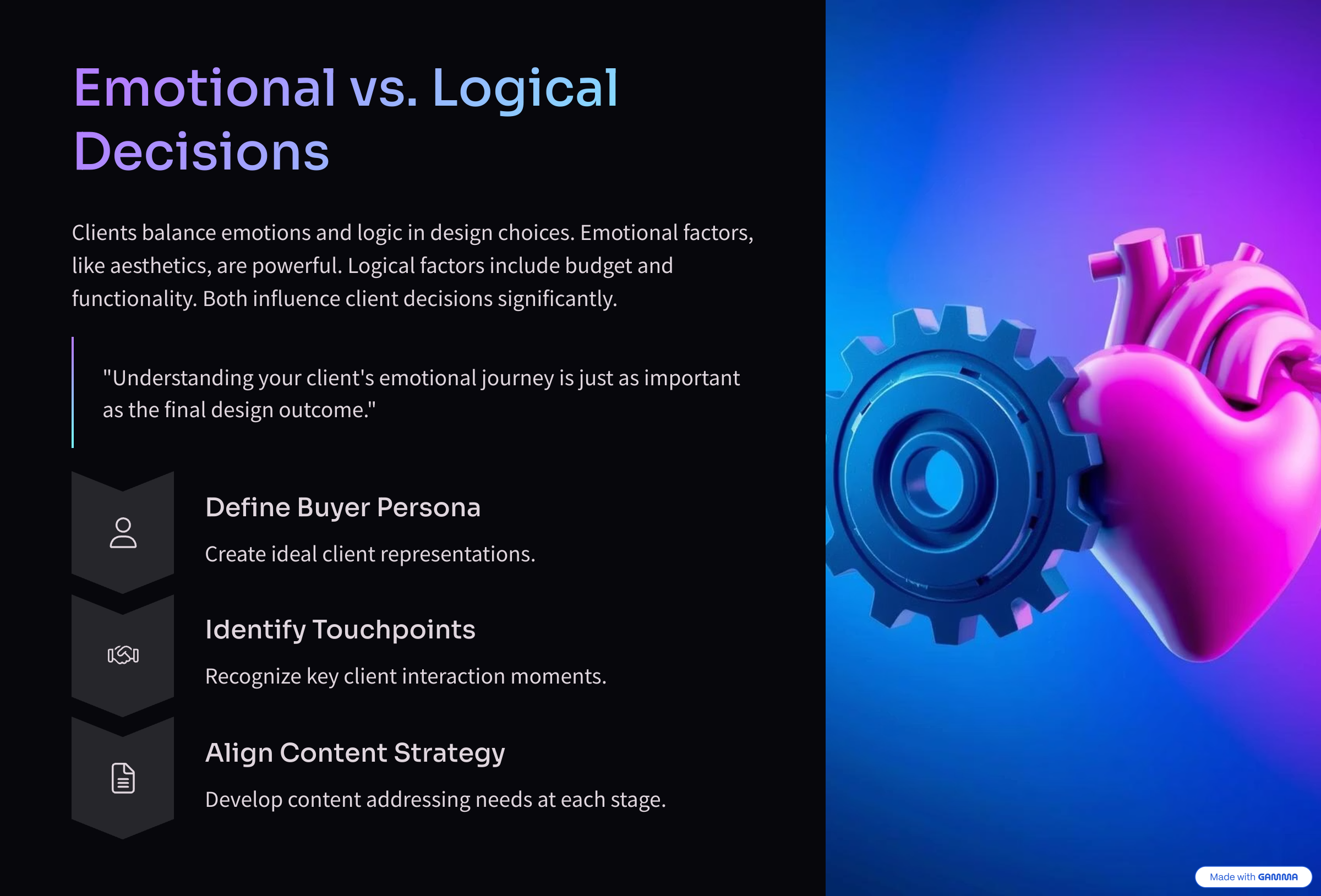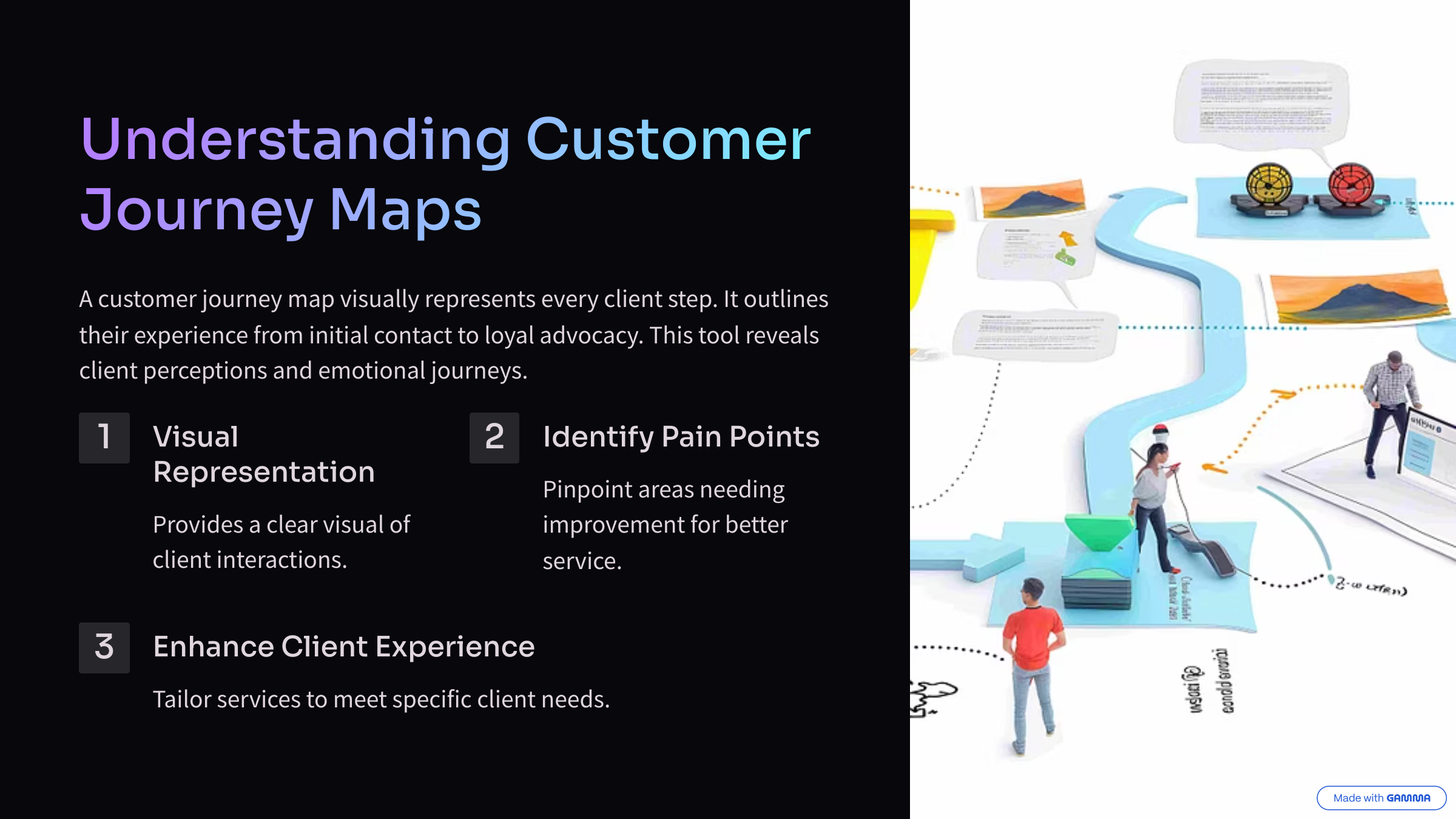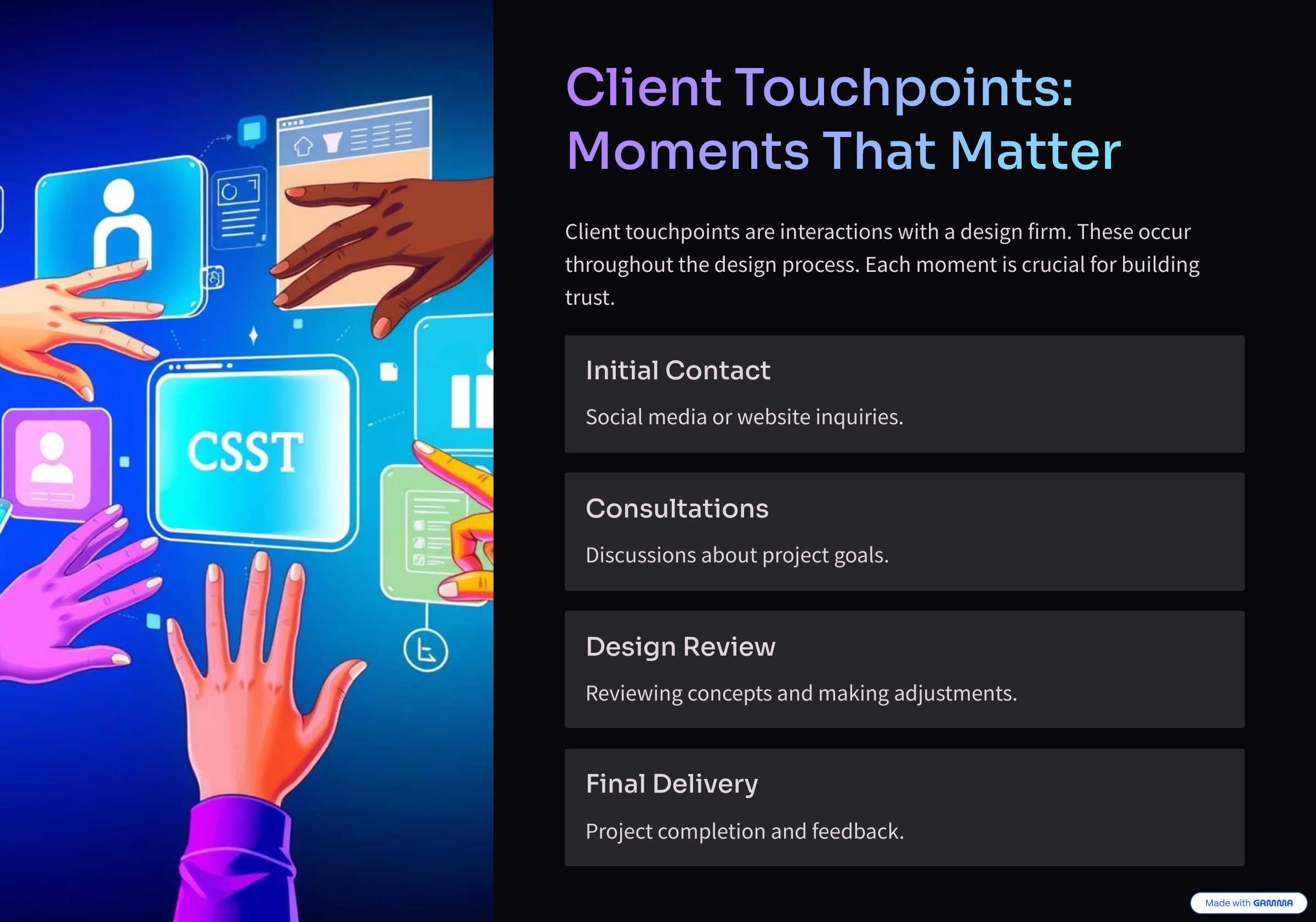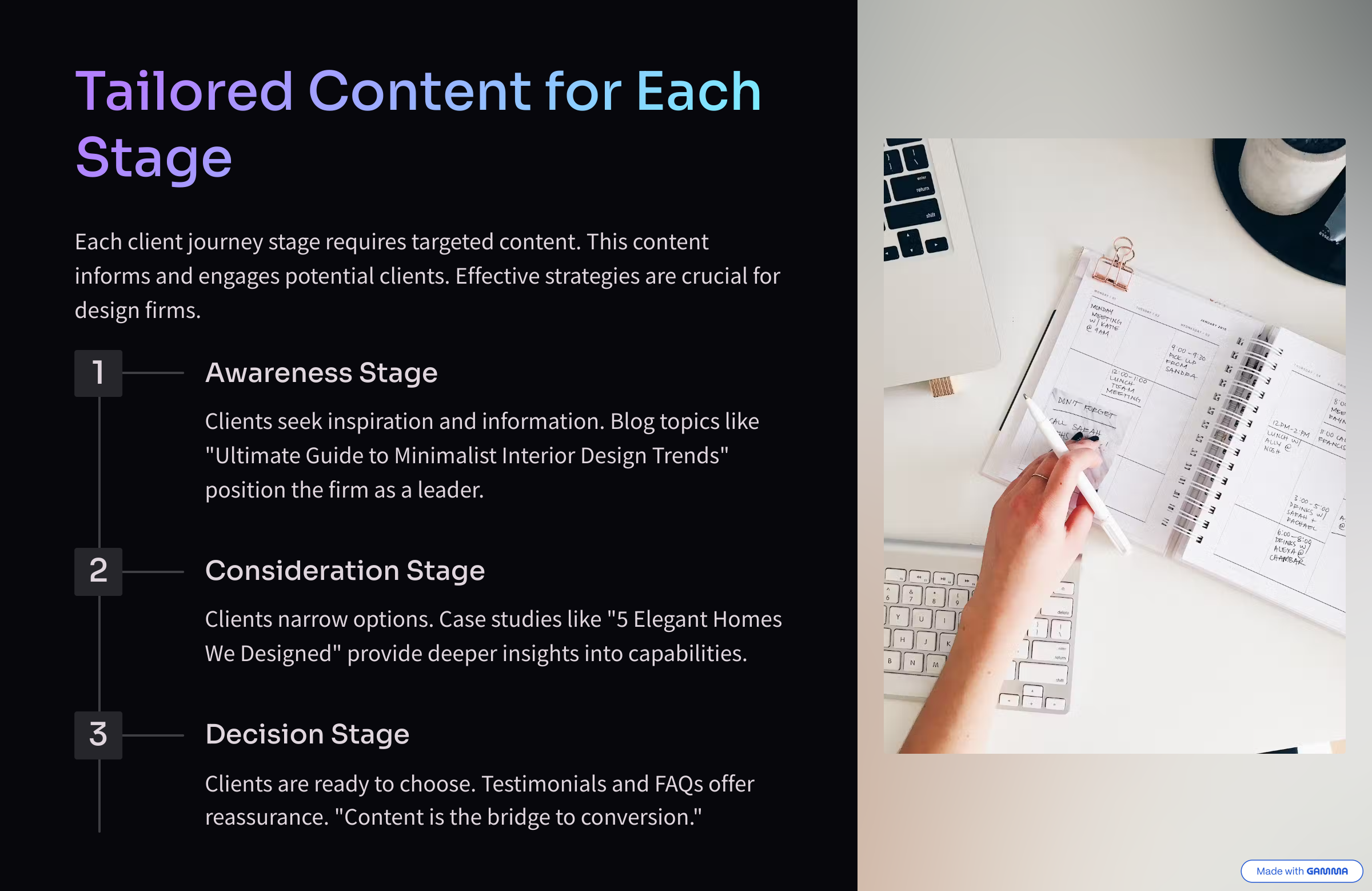Imagine a high-stakes scenario where a design firm pitches to a potential client. It’s not just the beauty of the portfolio that matters; it’s the entire client journey that influences their decision. This isn’t merely a service application—it’s an emotional investment. Many firms underestimate the importance of understanding every nuance of their client’s experiences, and that’s where customer journey mapping becomes a game changer. Let’s dive into how mapping can create meaningful connections in the creative industry.
Understanding the Customer Journey Map
What is a Customer Journey Map?
A customer journey map is a visual representation of every step a client takes when interacting with a design firm. It outlines their experience from the moment they first learn about your services to when they become loyal advocates. This tool is essential for understanding how clients perceive your firm and the emotional journey they undergo.
Why Are Customer Journey Maps Significant?
Customer journey maps are crucial for several reasons:
- Visual Representation: They provide a clear visual of client interactions.
- Identify Pain Points: By mapping the journey, firms can pinpoint areas needing improvement.
- Enhance Client Experience: Understanding the journey allows firms to tailor their services to meet client needs.
Importance for Design Firms
For design firms, the stakes are high. Clients invest emotionally in design projects. They seek not just a product but a transformation. A customer journey map helps align the design process with client expectations. It creates meaningful touchpoints that resonate with their emotional investments.
Emotional vs. Logical Decision-Making
When it comes to design choices, clients often navigate a complex landscape of emotions and logic. Emotional decision-making can be powerful. Clients may choose a design based on how it makes them feel. They might be drawn to a particular aesthetic or the promise of a unique experience. On the other hand, logical decision-making involves practical considerations, such as budget and functionality.
Understanding this balance is key. As one expert puts it,
“Understanding your client’s emotional journey is just as important as the final design outcome.”
Design firms must recognize that both emotional and logical factors influence client decisions.
How to Leverage Customer Journey Maps
To effectively use customer journey maps, design firms should:
- Define Buyer Persona: Create semi-fictional representations of ideal clients.
- Identify Touchpoints: Recognise key moments when clients interact with your firm.
- Align Content Strategy: Develop content that addresses client needs at each stage of their journey.
By focusing on these elements, design firms can enhance their client experience. They can build stronger relationships and ultimately drive business growth. The journey is not just about the final design; it’s about the entire experience clients have with your firm.
Defining Your Buyer Personas: The First Step to Mapping
Before diving into the intricate world of customer journey mapping, it’s crucial to first define your buyer personas. These semi-fictional representations of your ideal clients serve as a foundation for understanding who you are marketing to. They help you tailor your strategies effectively. But how do you go about creating these personas?
Identifying Key Demographics of Design Clients
Start by identifying the key demographics of your design clients. This includes factors like age, gender, income level, and location. For instance, a luxury yacht designer might focus on high-net-worth individuals, while an interior designer may cater to young families or urban professionals. Understanding these demographics allows you to segment your audience and create targeted marketing campaigns.
- Age: Are your clients mostly millennials, Gen X, or baby boomers?
- Income Level: What is their spending capacity? This can greatly influence their design choices.
- Location: Are they urban dwellers or suburban homeowners? This can affect design preferences.

Understanding Pain Points and Goals
Next, delve into the pain points and goals of your clients. What challenges do they face when seeking design services? Are they overwhelmed by choices? Do they have a limited budget? Understanding these aspects is vital. It allows you to position your services as solutions to their problems.
For example, a client might struggle with a lack of clarity in the design process. They may want a stunning aesthetic but fear the costs involved. By addressing these pain points, you can create a more appealing offer. What are their ultimate goals? Is it to create a functional space, or are they looking for something that reflects their personal style?
Crafting Personas from Visual Aids and Data
Once you have gathered this information, it’s time to craft your personas. Use visual aids and data to bring them to life. Create profiles that include a name, background, and even a photo. This makes them feel real. For instance, you might have a persona named “Sophia,” a 35-year-old marketing executive who seeks a modern, minimalist home design.
Utilizing data from surveys, social media insights, and client feedback can enhance your persona. The clearer your buyer personas, the more focused your marketing efforts can be. They can represent different client sectors like residential, commercial, or luxury. This segmentation allows for more personalized marketing strategies.
“The clearer your buyer personas, the more focused your marketing efforts can be.”
In summary, defining your buyer personas is an essential first step in mapping the customer journey. By identifying key demographics, understanding pain points and goals, and crafting detailed personas, design firms can create targeted marketing strategies. This not only enhances client satisfaction but also builds stronger relationships. So, take the time to understand your clients better. It will pay off in the long run.
Client Touchpoints: Moments That Matter
Defining Client Touchpoints in the Design Process
Client touchpoints are the moments when clients interact with a design firm. These interactions can happen at various stages of the design process. From the first inquiry to the final delivery, each touchpoint plays a crucial role. Think of it like a journey. Every step matters.
- Initial contact through social media or a website.
- Consultations and discussions about project goals.
- Reviewing design concepts and making adjustments.
- Final delivery and post-project feedback.
Each of these moments is an opportunity to build or break trust with your client. Understanding these touchpoints helps firms create a seamless experience. It’s not just about the design; it’s about how clients feel throughout the process.
Recognizing Influential Moments from Discovery to Post-Project
Every interaction can influence a client’s perception. For instance, when a client first discovers a firm, they might see a stunning portfolio image on Instagram. This moment can spark interest and lead to further exploration. But what happens next? If the firm responds quickly and provides valuable information, trust begins to build.
On the other hand, if a client feels ignored or receives unclear communication, it can lead to frustration. This is why recognizing influential moments is vital. Each stage, from discovery to post-project, has its own set of touchpoints that can either enhance or diminish client satisfaction.
Analyzing How Touchpoints Affect Client Satisfaction
Touchpoints are not just about interaction; they directly impact client satisfaction. A well-timed follow-up after a project can make clients feel valued. Conversely, a lack of communication can leave them feeling neglected.
To analyze these effects, firms can:
- Gather feedback through surveys or direct conversations.
- Monitor social media interactions and responses.
- Review project outcomes and client testimonials.
By understanding how each touchpoint affects satisfaction, firms can make informed adjustments. This leads to a better overall experience for clients. After all, satisfied clients are more likely to return and recommend the firm to others.
“Each touchpoint is an opportunity to build or break trust with your client.”
In conclusion, recognizing and optimizing client touchpoints is essential for design firms. These moments shape the client experience and can lead to long-lasting relationships. By focusing on these interactions, firms can enhance their service and stand out in a competitive market.
Creating Tailored Content for Each Stage of the Client Journey
In the world of design, understanding the client’s journey is crucial. Each stage of this journey requires targeted, strategic content. This content not only informs but also engages potential clients. So, how can design firms develop effective content strategies for the awareness, consideration, and decision stages?
1. Awareness Stage
At this initial stage, clients are just beginning their search. They are looking for inspiration and information. Content that resonates here is essential. Consider blog topics like:
- “Ultimate Guide to Minimalist Interior Design Trends 2023”
- “How Sustainable Architecture Can Revolutionize Urban Living”
These topics position the firm as an industry leader. They answer the questions clients have while sparking interest. Remember, the goal is to create a connection. After all, clients are often emotionally invested in their design choices.
2. Consideration Stage
Once clients have gathered information, they start narrowing down their options. This is where case studies and detailed guides come into play. Examples include:
- “5 Elegant Homes We Designed for Modern Living”
- “Choosing Between Modern vs. Traditional Yachts for 2024”
These resources provide deeper insights into the firm’s capabilities. They help clients visualize what working with the firm would be like. It’s about answering their questions and addressing their concerns.
3. Decision Stage
Finally, clients are ready to make a choice. At this point, the content should focus on reassurance. Testimonials, project case studies, and detailed service descriptions are vital. They can help answer last-minute questions. For instance, an FAQ guide can demystify the design process. This is where the quote rings true:
“Content isn’t just king; it’s the bridge to conversion when done right.”
Emotional Resonance
Using language that resonates emotionally with clients is key. Design is personal. Clients want to feel understood. By addressing their pain points and aspirations, firms can create a more meaningful connection. For example, a blog post about optimizing small spaces can speak directly to homeowners who feel overwhelmed.
Effective content addresses client questions at various touchpoints. It evolves alongside the client journey. By developing tailored content strategies for each stage, design firms can enhance client experiences. This not only builds trust but also fosters long-term relationships.
Regularly Revising the Customer Journey Map
In the fast-paced world of design, staying relevant is crucial. The customer journey map is not a one-time project; it requires ongoing assessment and updates. Why? Because the landscape of client expectations and market trends is always shifting. If a design firm fails to adapt, it risks losing touch with its clientele.

The Importance of Ongoing Assessment
Regularly revising the customer journey map allows firms to stay aligned with their client’s needs. Think of it like a compass. If it’s not calibrated, you might end up lost. By assessing the journey, firms can identify pain points and areas for improvement. This proactive approach not only enhances client satisfaction but also turns clients into advocates.
Adjusting to Current Design Trends
Design trends evolve rapidly. What was popular last year may not resonate today. For instance, the rise of sustainable design has changed client expectations. Clients are now looking for eco-friendly solutions. A firm that updates its journey map to reflect this trend can better serve its clients. They can showcase their commitment to sustainability, which can be a significant selling point.
Client Feedback: A Goldmine for Improvement
Client feedback is invaluable. It provides insights into what clients truly value. For example, if clients express a desire for more personalized service, a firm can adjust its journey map accordingly. This might involve enhancing communication touchpoints or offering tailored design options. As the saying goes,
“In design, staying static is a no-go. The same applies to your customer journey map!”
Example of a Shift in Client Expectations
Consider a design firm that initially focused on traditional styles. Over time, they noticed a shift in client preferences towards modern, minimalist designs. By revising their customer journey map, they could highlight their new offerings and adjust their marketing strategies. This shift not only attracted new clients but also retained existing ones who appreciated the firm’s adaptability.
Assessing Competition
Another aspect of revising the customer journey map is assessing competition. Understanding what competitors are doing can provide insights into your own strategies. Are they offering services that you don’t? Are they engaging clients in ways that you could improve upon? By keeping an eye on the competition, firms can refine their processes and stay ahead in the game.
Over time, your ideal clientele, services, and market trends will evolve. Regularly revising the customer journey map is not just about keeping up; it’s about leading the way. By committing to this practice, design firms can ensure they remain relevant and continue to provide exceptional service.
In conclusion, the customer journey map is a living document. It should evolve as your clients do. By embracing change and regularly updating your map, you can create a more meaningful experience for your clients. This not only enhances satisfaction but also fosters loyalty. So, take the time to review and revise your customer journey map. Your clients will thank you for it.
TL;DR: Harnessing the power of customer journey mapping helps design firms deliver exceptional client experiences, streamline their processes, and cultivate lasting relationships.
Why Customer Journey Maps Matter for Design Firms
For firms in creative industries like interior design, architecture, fashion, and product or yacht design, the client journey is often aspirational — clients dream of spaces, products, or solutions they aren’t yet sure how to achieve. Understanding their journey allows you to meet them at every stage, offer reassurance, and guide them to their ultimate goal. By blending clear communication, engaging content, and a seamless experience, your firm can stand apart from competitors while cultivating loyal, satisfied clients.

Start Mapping Your Client Journey Today
A customer journey map is your first step if your design firm is ready to go beyond breathtaking creations and deliver exceptional client experiences. Not only will it help you understand your client base better, but it will also refine your processes, making every interaction with your firm more meaningful. Want help creating a customer journey map or refining your marketing strategy? Our agency specializes in working with design-focused firms just like yours. Let’s map out your journey to success together.




